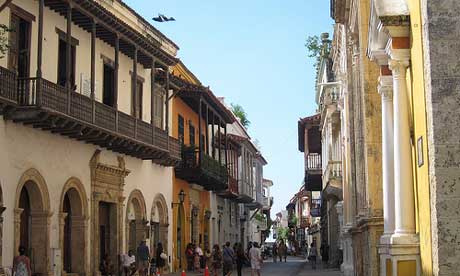
Explore Cartagena; a World Heritage site, with extensive fortifications, graceful courtyards, great dining spots and nightlife
It’s sundown in Cartagena. Somewhere in the thread of streets below the city’s colonial church domes and crumbling roof terraces, someone is singing. The sound of a high, robust female voice pipes in and out of my balcony and, carried on the city’s restless breeze, seems to fill up El Centro from wall to ancient wall.
Cartagena’s old town (El Centro) is undergoing something of a renaissance. The salt-corroded facades of its old colonial casas‚ are being given a make-over, the graceful courtyards of its convents modified into quietly exclusive hotels and dining spots that have become the toast of South American society from Buenos Aires to Bogotá. But despite the click of designer stilettos on its long-neglected cobbles, Cartagena de Indias remains, determinedly, a port town (the second largest in Colombia); part cosmopolitan glamour, part Costeño, with the circling persistence of street vendors’ calls and the adherent fisherwoman’s song.
A World Heritage Site, home to the most extensive fortifications in South America, this Spanish-settled city on the Colombian Caribbean has more than enough points of historical interest to keep a guidebook-clutching tourist happy for days. But Cartagena is not a place to be hurried. Even given the revitalising breeze, which makes permanent percussion out of the ship’s masts in the city’s many marinas, the tropical heat ensures that the pace is slow. Its museums, convents and leafy plazas are lingered in as much for shade as for education.
After sundown it’s a different matter. Nowadays, the best nocturnal life takes place within the 17-metre-thick walls of the old town. They’re still immaculately preserved despite the constant beatings they took during the 16th century from gold-seeking pirates – the most vicious of which was our own Sir Francis Drake who only called off the cannons after receiving ten million pesos in ransom. Today, it’s party-seeking South Americans who besiege the city walls, walking along the murallas to greet the sunset – but watch out for your wallet here; landlubbing pirates still linger.
Near the eastern corner of the city walls visit the Bóvedas. The 23 dungeons were built into the city walls during the late 1700s but are now a spot to capture tourists, with cells converted into shops selling quality handicrafts such as Costeña dolls or Guajiran hammocks.
And at the western end, shopping with slightly more sinister foundations is to be found at the Plaza de los Coches, the site of a former slave market. It’s also known as El Portal de los Dulces due to the candy stalls which line the streets here. For a few pesos, sample typical sweets such as tamarind balls and cookies made with sesame, coconut and fruit.
Beyond the walls, the modern neighbourhood of Bocagrande once constituted a Little Miami for holidaying South Americans. Today the best of the city’s smart hotels and clubs are within the walls of El Centro, leaving the high-rises, neon-lit bars and private beaches to long-term residents and business conferences. Head here at the beginning of November however, and the atmosphere is once again as frenetic as it was during its 1970s heyday. Colombia’s national beauty pageant, the Concurso Nacional de la Belleza, is Cartagena’s biggest bash – Bocagrande’s Avenida San Martín becomes populated by girls with legs as long as the row of zeros on their managers’ pay cheques. Beauty is big business here. The winner of the contest, known locally as ‘Reinas de los Operaciones’ (Queen of Operations – it seems many of them aren’t natural beauties) is announced on Cartagena’s Independence Day, with street parades and fiestas firing up at least a week before.
Cartagena is certainly a city with its salsa shoes well worn-in (head for Quiebra Canto, near the Parque del Centenario to kick up your heels in what is one of the country’s most famous salsa clubs). But it is also a place that has been a creative home to the likes of Gabriel García Márquez and the esteemed Colombian painter, Alejandro Obregón. His sensual murals of the Caribbean grace the walls of Bocagrande’s Hilton hotel, his paintings the Museo de Arte Moderno. But of all the city’s celebrated residents, it was South American liberator Simón Bolívar who best summed up Cartagena when he dubbed it ‘La Heroica’ on independence in 1821. Robust, dignified and ever ready to party, Cartagena certainly still lives up to its historic name.
When to go: Temperatures are warm year-round. The dry season (December-April) conveniently coincides with the European winter but the weather is accommodating regardless of the season. Christmas, Easter and the second week in November, when the National Beauty Contest takes place, are when Cartagena really puts its fiesta frock on.